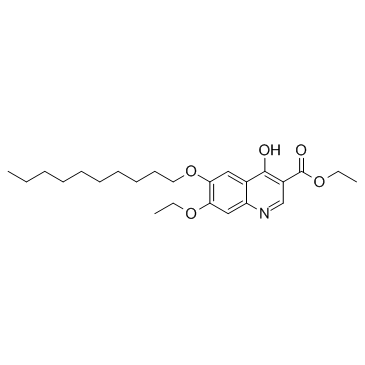Decoquinate

Decoquinate structure
|
Common Name | Decoquinate | ||
|---|---|---|---|---|
| CAS Number | 18507-89-6 | Molecular Weight | 417.538 | |
| Density | 1.1±0.1 g/cm3 | Boiling Point | 517.9±45.0 °C at 760 mmHg | |
| Molecular Formula | C24H35NO5 | Melting Point | 86-87ºC | |
| MSDS | Chinese USA | Flash Point | 267.0±28.7 °C | |
|
Efficacy of selected oral chemotherapeutants against Ichthyophthirius multifiliis (Ciliophora: Ophyroglenidae) infecting rainbow trout Oncorhynchus mykiss.
Dis. Aquat. Organ. 55(1) , 17-22, (2003) The chemotherapeutic efficacy of 6 in-feed compounds against Ichthyophthirius multifiliis Fouquet, 1876 was assessed using experimental infections of rainbow trout Oncorhynchus mykiss (Walbaum) fingerlings. Trial doses of 104 ppm amprolium hydrochloride or 65... |
|
|
Efficacy of decoquinate against Sarcocystis neurona in cell cultures.
Vet. Parasitol. 196(1-2) , 21-3, (2013) Decoquinate is a quinolone anticoccidial approved for use in the prevention of intestinal coccidiosis in farm animals. This compound has good activity against Toxoplasma gondii and Neospora caninum in cell cultures. The drug acts on the parasites' mitochondri... |
|
|
Relative virulences of a drug-resistant and a drug-sensitive strain of Eimeria acervulina, a coccidium of chickens.
Vet. Parasitol. 135(1) , 15-23, (2006) The virulence of a field strain of the chicken coccidian parasite Eimeria acervulina (Boreham I), dually resistant to the chemically unrelated anticoccidial agents decoquinate and clopidol, was compared with that of a drug-sensitive laboratory strain (Ongar) ... |
|
|
The mode of action of anticoccidial quinolones (6-decyloxy-4-hydroxyquinoline-3-carboxylates) in chickens.
Int. J. Parasitol. 27(1) , 101-11, (1997) The anticoccidial mode of action of quinolones (6-decyloxy-4-hydroxyquinoline-3-carboxylates) against Eimeria tenella and E. acervulina in chickens has been investigated, using decoquinate and M&B 15,584 as examples. The well known static effect on sporozoite... |
|
|
Effect of different decoquinate treatments on cryptosporidiosis in naturally infected cashmere goat kids.
Vet. Rec. 157(9) , 261-2, (2005)
|
|
|
Effect of the quinolone coccidiostat decoquinate on the rearrangement of chromosomes of Eimeria tenella.
Int. J. Parasitol. 36(14) , 1515-20, (2006) The present report concerns our attempts to further study the effect of quinolone coccidiostats on the sporulation of Eimeria tenella oocysts by analyzing the meiotic behaviour of the chromosomes. To that end, synaptonemal complexes were analyzed by TEM appli... |
|
|
Cytochrome b mutation identified in a decoquinate-resistant mutant of Toxoplasma gondii.
J. Eukaryot. Microbiol. 46(5) , 81S-82S, (1999)
|
|
|
Oral pharmacokinetics and milk residues of decoquinate in milking cows.
J. Vet. Pharmacol. Ther. 32(4) , 403-6, (2009)
|
|
|
The history of decoquinate in the control of coccidial infections in ruminants.
J. Vet. Pharmacol. Ther. 35(5) , 417-27, (2012) Decoquinate is a quinolone derivative that has been used for over 20 years in the control of coccidiosis in domestic ruminants. Decoquinate treats coccidiosis in lambs and calves and prevents coccidiosis in lambs when administered in feed at a dosage of 1 mg ... |
|
|
Residue depletion of decoquinate in chicken tissues after oral administration.
J. Vet. Pharmacol. Ther. 36(2) , 116-21, (2013) A rapid, sensitive, and reliable high-performance liquid chromatography tandem mass spectrometry (LC-MS/MS) method was developed and validated for the analysis of decoquinate in chicken tissues. The compounds were extracted using acetonitrile by liquid-liquid... |